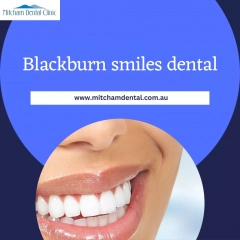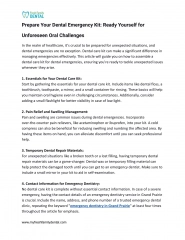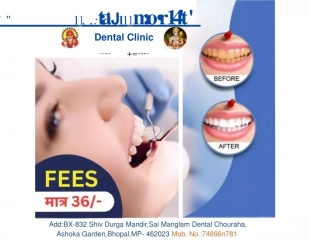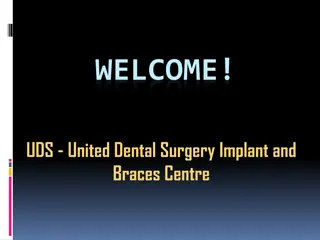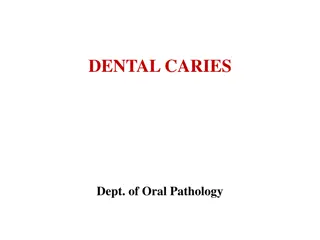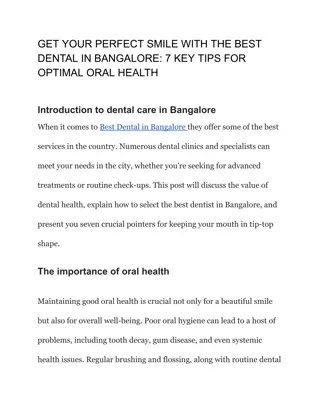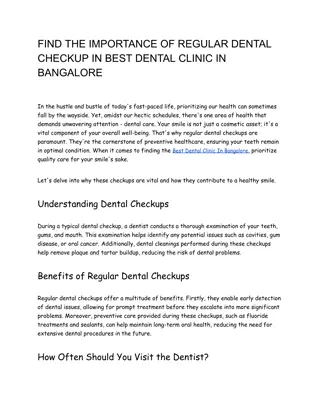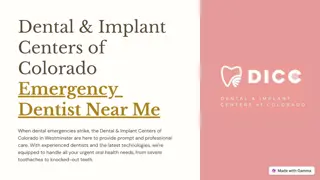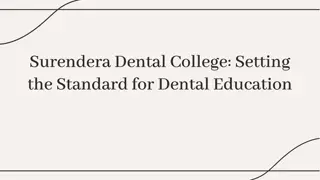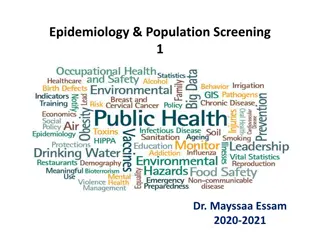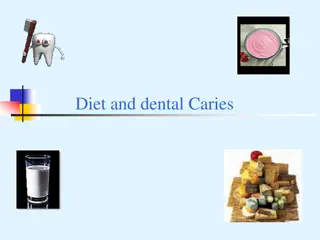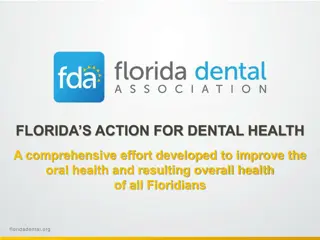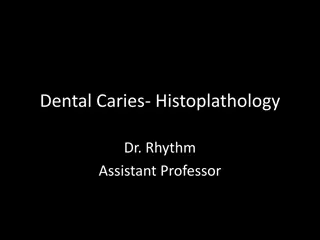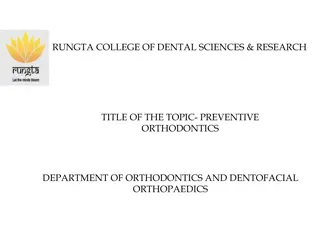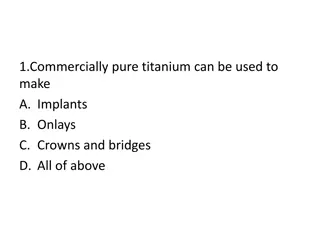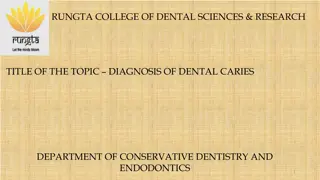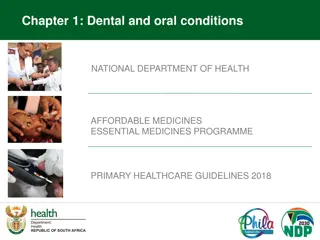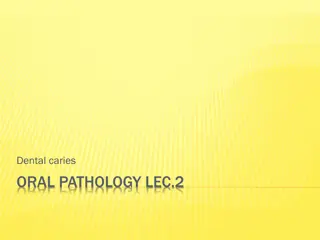Epidemiology of Dental Caries: An Insight into Disease Frequency and Distribution
Defined as an infectious microbiologic disease, dental caries has shown an alarming rise, especially in developing countries due to dietary changes and modern civilization. Historical evidence and contemporary data shed light on the prevalence and impact of dental caries, emphasizing the relationship between diet and disease development. Various theories regarding caries etiology, from early concepts to modern understandings, further highlight the complexities of this oral health issue.
Uploaded on Mar 02, 2025 | 1 Views
Download Presentation

Please find below an Image/Link to download the presentation.
The content on the website is provided AS IS for your information and personal use only. It may not be sold, licensed, or shared on other websites without obtaining consent from the author.If you encounter any issues during the download, it is possible that the publisher has removed the file from their server.
You are allowed to download the files provided on this website for personal or commercial use, subject to the condition that they are used lawfully. All files are the property of their respective owners.
The content on the website is provided AS IS for your information and personal use only. It may not be sold, licensed, or shared on other websites without obtaining consent from the author.
E N D
Presentation Transcript
EPIDEMIOLOGY OF DENTAL CARIES
CONTENTS INTRODUCTION EPIDEMIOLOGY EPIDEMIOLOGICAL FACTORS OF DENTAL CARIES DIETARY STUDIES ON CONTROLLED HUMAN POPULATION CONCLUSION REFERENCE
INTRODUCTION Epidemiology is defined as the study of the distribution and determinants of disease frequency in man . The word epidemiology is derived from the Greek word epidemic. Epi=upon, demos= people and logos=study orscience.
Dental caries is defined as an infectious microbiologic disease of the teeth that results in localized dissolution and destruction of the calcified tissues . The word caries is derived from Latin, meaning rot or decay . It is similar to the Greek word Ker meaning death.
There is presently an alarming rate of increasing in the prevalence of dental caries in developing countries. The introduction of sucrose into the modern diet has been associated with increased caries prevalence. The relationship between diet and dental caries is ` Bacterial Enzyme + Fermentable Carbohydrate = Acid Acid+ Enamel = Dental Caries
EPIDEMIOLOGY Dental caries may be considered a disease of modern civilization, since prehistoric man rarely suffered from of tooth destruction. Anthropologic studies of Von Lenhossek revealed that the Dolicocephalicskulls of men from pre-neolithic periods(12,000BC) did not exhibit dental caries,but skulls from Brachycephalic man of Neolithic periods (12,000-3000BC) contained carious teeth.
WHO reported a DMFT score of 3.94for India in 2003. In India, data from the National Oral Health Survey (2002-2003) states that in children aged 12 years, the caries prevalence was 53.8% and mean DMFT was 1.8 whereas it was 80.2% and 5.4 in the 35-44 year age group. In the 65-74 year age group, the prevalence was 85% and the mean DMFT was 14.9.
THEORIES OF CARIES ETIOLOGY EARLY THEORIES The legend of the worm ENDOGENOUS THEORIES Humoral theory Vital theory EXOGENOUS THEORIES Chemical (acid) theory Parasitic or Septic theory Miller s chemico - parasitic theory (Acidogenic theory) The Proteolytic theory The Proteolysis Chelation theory
Early theories The legend of the worm The earliest reference to tooth decay and toothache came from the ancient Sumerian text known as The legend of the worm .
ENDOGENOUS THEORIES Humoral theory The four elemental humors of the body were blood, phlegm, black bile and yellow bile.
Chemical (acid) theory In the 17thand 18thcentury, there emerged the concept that teeth were destroyed by acids formed in the oral cavity. Robertson (1835) proposed that dental decay was caused by acid formed by fermentation of food particles around teeth.
Parasitic (septic ) theory: Early microscopic observation of scrapings from teeth and of the carious lesions by Antoni Van Leeuwenhock (1632- 1723) indicated that microorganisms were associated with the carious process.
Millers chemico - parasitic theory (Acidogenic theory) This theory was proposed originally by W.D. Miller in 1890. He made the significant observation that many organisms can produce acid from the fermentation of sugar and showed that several oral microorganism have this property and lactic acid is one of the major acids formed. He also showed that extracted human teeth could be demineralized by incubation in mixtures of bread or sugar with human saliva.
STEPHANS CURVE Stephan showed that within 2-4 minutes of rinsing with a solution of glucose/sucrose, plaque PH is reduced from about6.5-5 and gradually returns to the original value within approximately 40 minutes. This is known as stephan s curve.
Proteolytic theory: In 1947, Gottlieb, suggested that the initial attack on enamel might be the destruction of organic material rather than demineralization by acid. Thus, according to this theory, the organic matrix would be attacked before the mineral phase of the enamel. The proteolytic enzymes liberated by oral bacteria destroy the organic matrix of enamel, loosening the apatite crystals, so that they are eventually lost and the tissue collapses.
Proteolytic chelation theory: (Schatz & Martin in 1955) It proposes that some of products of bacterial action on enamel, dentin and food and salivary constituents can form chelates with calcium. A chelate is a complex between an ion (Ca) & two or more groups of complexing compound. Since chelates can be formed at neutral or alkaline pH, the theory suggested that demineralization of the enamel could arise without acid formation.
Jenkins & Dawes carried out studies to discover whether chelation plays a role in the etiology of caries. They concluded that saliva and plaque do not contain substances in sufficient concentrations to chelate calcium in detectable amounts from enamel. Although chelation is unlikely to be involved in the initiation of the lesion, it may play a minor role in the established lesion.
EPIDERMIOLOGICAL FACTORS OF DENTAL CARIES Enviromental factors Host factors Agent factors
HOST FACTORS 1.TOOTH The morphological characteristics of tooth have been suggested as influencing of initiation of dental caries. Presence of deep narrow occulsal fissures or buccal and lingual pits tend to trap food bacteria and debris. Tooth position may play a role in dental caries.
2.SALIVA Functions of saliva with respect to caries is its role in the removal of bacteria and food debris from the mouth. When saliva is swallowed, any bacteria contained therein are removed from the oral cavity. The composition of saliva varies between persons and concentrations of inorganic calcium and phosphorous show considerable variation, depending upon the rate of flow.
Quantity: The quantity of saliva secreted normally is 700- 800ml/ day. The quantity of saliva may influence caries incidence as is especially evident in cases of salivary gland aplasia and xerostomia.
Antibacterial Properties Lactoperoxidase Lysozyme Lactoferrin IgA
GENDER studies have show that the prevalence of dental caries is higher among females compare to males. This might be due to the early eruption of teeth among girls.
RACE Dental caries prevalence is more in white people compare to black people.
AGE Age is directly and strongly associated with the prevalence of dental caries. It is more commonly seen in childhood. Caries of enamel more prevalent among the younger's Root caries is more prevalent in the elderly.
FAMILIAL AND GENETIC PATTERNS Studies have clearly shown that BAD TEETH RUN IN FAMILIES . Inheritance of a characteristic tooth structure has lesser influence than environmental factors.
DEVELOPMENTAL DISTURBANCES The presence of Enamel Hypoplasiaand Enamel defects make the tooth more prone to dental caries
ECONOMIC STATUS Studies have shown higher socio economical status groups, decayed component was higher to compare the lower socio economical status group. ORAL HYGIENIE HABITS Dental caries is found to be less among those who maintain good oral hygiene.
AGENT FACTORS MICROFLORA A Variety of microbial factors associated with caries activity. Relation between Streptococcus Mutans and development of early carious lesion of enamel. Lactobacilli associated with dentinal caries and Actinomyces strains with root surface caries
Role of micro organism in caries Micro organism are a prerquisite for caries initiation. A single type of micro organism is capable of inducing caries Streptococcus strains that are capable of inducing caries are also able to synthesize extracellular dextrans or levans. Acid production is a prerequisite for caries, but not all acidogenic organisms are cariogenic.
Role of cariogenic plaque The rate of sucrose consumption was higher More lactic acid is formed from stored intracellular polysaccharides. Higher levels of streptococcus mutans Lower levels of streptococcus sanguis and actinomyces.
ENVIROMENTAL FACTORS DIET Defined as the types and amount of food eaten daily by an individual. Nutrition Defined as the sum of the process by which an individual takes in and utilizes food Physical properties of food and cariogenicity It may be significant by affecting food retention, food clearance, solubility and oral hygiene. Physical nature of diet The diet id primitive man consisted a great deal of roughage. which cleanses the teeth of adherent debris during mastication. In modern diet soft refined food tends to cling tenaciously to the teeth are not removed because lack of roughage
CABOHYDRATE CONTENT OF DIET Fermentable carbohydrates are on of the most important causing dental caries. Increase intake of refined carbohydrates are directly proportional in causing the dental caries. Vitamin content of diet Vit.A and Vit.D necessary for the development of teeth Vit.K has the capacity of enzyme inhibiting activity in the carbohydrate degradation cycle. VIT.B complex and Vit.B6 has been purposed as an anti caries agent
GEOGRAPHICAL VARIATIONS LATITUDE In USA,the north eastern region has the highest and south central region the lowest prevalance of dental caries. DISTANCE FROM SEA COAST Caries pravelance is maximum at the sea cost and more distance travelled away from the costal region there will be less caries activity.
TEMPERATURE Lower temperature higher the caries prevalance. RELATIVE HUMIDIT Show higher correlation with caries prevalance.Higher humidity more moisture in the Atmosphere which the uv rays and sunlight. Hence increase caries activity. RAINFALL Acts by leaching off minerals including fluoride from soil and also by blocking sunlight. rainfall are linked to dental caries prevalence.
URBANIZATION WHO studies showed higher caries scores in urban areas,where the higher consumption of refined food stuff by the urban community is observed. SOCIAL FACTORS It like Economic status,provisionof good preventive measures,social pressure might create more demand for better dental care and leads to lesser caries prevalance.
INDUSTRIAL HAZARDS To the teeth probably belong in economic category.carbohydrate dust and acid formers are both to be deletoirus to the teeth,one promoting caries and other chemical erosions.
SUNSHINE Ultraviolet light from the sun promotes synthesis of Vitamin D and along with other factors.it might account for lower caries experience. FLUORIDE Higher the fluoride content in soil and ground water,lesser the caries.
DIETARY STUDIES ON CONTROLLED HUMAN POPULATION VIPEHOLM STUDY Described by Gustaffson et al in 1954. Five year investigation of 436 adult inmaters of Vipeholm Hospital in Lund,Sweden,an institution for mentally challenged. Purpose the study; To find out 1)Does an increase in carbohydrate intake cause an increase in caries? 2)Does an increase in carbohyrade intake produce a decrease in caries?
METHOD The institutional diet was nutrious,butcontained little sugar,with no provision for between meal snacks. The experimental design divided inmates 1 control $ 6 experimental groups. 1)A control group 2)A sucrose group 3)A bread group 4)A chocolate group 5)A caremel group 6)A 8 tofeegroup 7)A 24 tofeegroup
CONCLUSION OF THIS STUDY An increase in carbohydrate diet definitely increase the caries activity. The risk of caries is greater if the sugar is consumed in the form that will retained on surfaces of the teeth. The risk of sugar increasing caries activity is great.if the sugar is consumed between meals. Upon the withdrawal of the sugar rich foods, increased caries activity disappears.
DRAWBACK OF THE STUDY The groups made up from the patients in individual wards with no possibility of matching the age of initial caries status. Mentally challenged patients did not always follow the instruction correctly. It is considered unethical to alter diet experimentally in direction likely to increase caries.
HOPE HOOD HOUSE STUDY Conducted by SULLIVAN in 1958. The dental status of children between 7 to 14 yrs of age residing at hope hood house,Newsouth waleswas studied longitudinally for 10 yrs. All lived in a strict natural diet,with exception of occasional serving of egg yolk was entirely vegetables in natural and largely raw. At the end of ten year,13 tear old children had a mean DMFT per child of the 1.6 the corresponding general was 10.7.
TURKU SUGAR STUDY The study was carried out by Turk, Finland. Aim of the study To compare the cariogenicity of sucrose, fructose and xylitol. Finding of the study Sucrose and fructose are equal cariogenicitywhereas xylitol produced almost no caries. By second year, the caries had continous to increase the sucrose group but remaine unchanged in the fructose,where as xylitol produced almost no caries Xylitol was non cariogenic.
CONCLUSION Since dental caries is a highly prevalent disease, control of dental caries is concern of all the people. The ideal control measures for dental caries must have immediate, high and lasting effectiveness, be innocuous and reach all of the people at lost in money and facilities well within the economic capabilities of the community.
REFERENCES SOBEN PETER-Essentials of public health Dentistry (community Dentistry)5thEdition. SS. HIREMATH-Text book of preventive and community Dentistry 2ndEdition.


